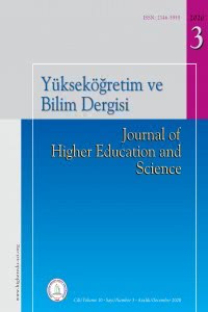21. Yüzyılda Uzaktan Öğretimde Paradigma Değişimi
Uzaktan öğretim, 21. Yüzyıl becerileri, Paradigma değişimi, Akademik disiplin
Paradigm Shift in Distance Education in the 21st Century
___
- Akan, H. (2012). Yükseköğretimde reform mu, onarım mı? Yükseköğretim ve Bilim Dergisi, 2(1), 24-25.
- Akdemir, O. (2011). Yükseköğretimimizde uzaktan eğitim. Yükseköğretim ve Bilim Dergisi, 1(1), 69-71.
- Aydın, C. H. (2005). Açık ve uzaktan öğrenmede kullanılan basılı materyallerdeki anlatım biçimine ilişkin öğrenen tercihleri. Anadolu Üniversitesi Sosyal Bilimler Dergisi, 5(1), 131-147.
- Baruque, L. B., & Melo, R. N. (2004). Learning theory and instruction design using learning objects. Journal of Educational Multimedia and Hypermedia, 13(4), 343-370.
- Bates, T. (2014). The role of technology in distance education (Routledge Revivals). London: Taylor & Francis
- Casey, D.M. (2008). A journey to legitimacy: The historical development of distance education through technology. TechTrends: Linking Research and Practice to Improve Learning, 52(2), 45-51.
- Coldeway, D. O. (1988). Research: Methodological issues in distance educational research. American Journal of Distance Education, 2(3), 45-54
- Crawford, J. (2009). Learning theories related to distance education: Learning theories that encompass distance education. Boise State University. April, 28, 2009. Retriewed from http://edtech2.boisestate.edu/crawfordj/portfolio/files/5_ Learn_theories.pdf
- Dick, W. O., Carey, L., & Carey, J. O. (2004). Systematic Design of Instruction. Boston: Allyn & Bacon.
- Feasley, С. (1991). The research, evaluation, and documentation of independent study. In Watkins B., & Wright S. (1991). The foundations of American distance education. Dubuque, Iowa: Kendal
- Gunawardena, C.N. & McIsaac, M. S. (1996). Distance education. In Handbook of Research in Educational Communications and Technology. Jonassen D. H. (Ed.) (2nd ed.). (pp. 355-395). Mahwah, NJ: Lawrence Erlbaum.
- Hutchins, R. M. (1969). The learning society. 111 Fourth Avenue, New York: Praeger
- Kuhn, T. S. (2008). Bilimsel devrimlerin yapısı. (Çev: Kuyaş N.) İstanbul: Kırmızı Yayınları.
- McLuhan, M. (1964). Understanding media. The extensions of man. New York: Mentor. Retriewed from http://robynbacken. com/text/nw_research.pdf
- ma değişiminin ışığında uzaktan öğretimin günümüz yükseköğ
- Simonson, M., Schlosser, C., & Hanson, D. (1999). Theory and distance education: A new discussion. American Journal of Distance Education, 13(1), 60-75.
- Simonson, M., Schlosser, C., & Orellana, A. (2011). Distance education research: A review of the literature. Journal of Computing in Higher Education, 23(2-3), 124-142.
- Toffler, A. (1981). Üçüncü dalga. (Çev: Seden A.). İstanbul: Altın kitaplar.
- Toprak, M., & Erdoğan, A. (2012). Yaşamboyu öğrenme: Kavram, politika, araçlar ve uygulama. Yükseköğretim ve Bilim Dergisi, 2(2), 69-91.
- UNESCO/COL, (2005). Perspectives on distance education: Lifelong learning and distance higher education. McIntosh C. (Ed). Paris: UNESCO Publishing. Retriewed from http://unesdoc. unesco.org/images/0014/001412/141218e.pdf
- Watkins, R., & Schlosser, C. (2003). Conceptualizing educational research in distance education. Quarterly Review of Distance Education, 4(3), 331-341.
- Zawacki-Richter, O. (2009). Research areas in distance education: A Delphi study. International Review of Research in Open and Distance Learning, 10(3), 1-17. Retriewed from http://ltc-ead. nutes.ufrj.br/constructore/objetos/Zawacki-Richter_delphi. pdf
- ISSN: 2146-5959
- Yayın Aralığı: 3
- Başlangıç: 2011
- Yayıncı: Bülent Ecevit Üniversitesi (Önceden Zonguldak Karaelmas Üniversitesi)
Türkiye'de Yükseköğretim Kurumlarında İş Sağlığı ve Güvenliği Eğitiminde Güncel Durum
Türkiye'de Harita/Geomatik Mühendisliğinde Yapılan Doktora Tezlerinin İçerik Analizi
Tahsin BOZTOPRAK, Osman DEMİR, YAKUP EMRE ÇORUHLU
Üniversite Tercihlerine Etki Eden Faktörlerin İncelenmesi: Türkiye Genelinde Bir Alan Araştırması
KAHRAMAN ÇATI, EMEL İŞTAR IŞIKLI, Haya ÖZCAN
21. Yüzyılda Uzaktan Öğretimde Paradigma Değişimi
Denizcilik Programlarının İstihdam Boyutunun Öğrenci Görüşlerine Göre Değerlendirilmesi
Erciyes Üniversitesi Tıp Fakültesi Birinci Sınıf Öğrencilerinin Devamsızlığa İlişkin Tutumları
ZEYNEP BAYKAN, Mehmet KILINÇ, MELİS NAÇAR
Öğrenci Görüşlerine Göre Öğretim Elemanlarının Pedagojik Yeterlikleri
